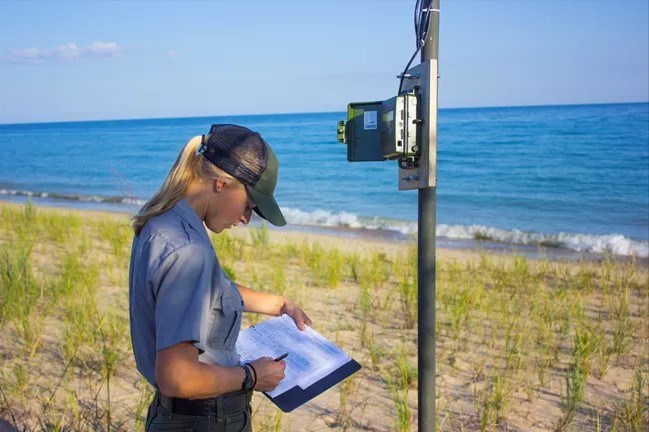Last updated: October 26, 2023
Article
Bats of Indiana Dunes

NPS / Erickson Smith
Indiana Dunes National Park hosts at least seven bat species: big brown bat (Eptesicus fuscus), eastern red bat (Lasiurus borealis), hoary bat (Lasiurus cinereus), silver-haired bat (Lasionycteris noctivagans), little brown bat (Myotis lucifugus), evening bat (Nycticeius humeralis), and tricolored bat (Perimyotis subflacus). Little brown bat, and tricolored bat, and evening bat are each listed as endangered in the State of Indiana.
Two additional species may be present but require more research: Indiana bat (Myotis sodalis) and northern long-eared bat (Myotis septentrionalis). Both species are state-listed and federally endangered.
The only true-flying mammals, bats accomplish flight through elongated hands and patagia (bat wings). There are over 1,000 bat species worldwide. Like other mammals, bats produce milk to feed their young, which are called ‘pups’. Females typically birth one pup per year. Many bats have good eyesight, but most species use echolocation to ‘see’ using their ears at night.
White-nose syndrome (WNS) is a fungal disease that causes spores to grow on the skin of cave-dwelling hibernating bats. WNS causes bats to awaken prematurely from hibernation, deplete their energy reserves, and succumb to starvation before spring arrives. Since the disease’s introduction to the United States in 2006, over one million little brown bats have died of WNS. The disease is known to have a 75-98% mortality rate. Other threats to local bats include climate change and habitat loss.

NPS
Due to these conservation concerns, the National Park Service (NPS) and other federal agencies have begun implementing or expanding bat research and monitoring programs. The Great Lakes Inventory and Monitoring Network initiated an acoustic monitoring program for bats in 2015. Acoustic monitoring uses devices in the field that record and store sounds to be further analzyed with software. Acoustic monitoring for Bats at Indiana Dunes National Park began in 2016.
The project goal is to understand which bat species are present and their relative abundance, as well as to track changes in which calls are heard at a given location. The most up-to-date report was published by Katy Goodwin and Alan Kirschbaum of the NPS in 2022, summarizing data from 2016-2019:
Activity levels for six of the nine species (big brown bat, hoary bat, silver-haired bat, evening bat, northern long-eared bat, and Indiana bat) appeared to be stable or slightly increasing. For northern long-eared and Indiana bats, observed activity levels were very low in all four years, so we may not have adequate data to assess trends for those species. The remaining three species (eastern red bat, little brown bat, and tricolored bat) showed slightly decreasing trends.
All are insectivores belonging to the Family Vespertilionidae, the largest and most common group of bats in North America. Great Lakes bat species can be divided into two groups: tree-roosting, migratory bats and cavity-roosting, hibernating bats. The hibernating species are highly susceptible to WNS, except for big brown bats (Eptesicus fuscus), which show greater resistance to the disease and experience less severe infections.
Acoustic monitoring is conducted during the summer, from June 1st– August 15th. The same sites are monitored each year in approximately the same order and at approximately the same time of year, to facilitate estimation of long-term trends. Each site is sampled once per year, for a period of 7–14 consecutive nights. Detectors are programmed to record every night from 6:00 p.m. to 8:00 a.m.
Eastern red bat made up the largest proportion of files in 2016 (35%), while big brown bat made up the largest proportion of files in 2017–2019 (42%–50%) (Figure 5). Big brown and eastern red bat files were numerous every year, but four species were rarely recorded. Little brown, northern long-eared, Indiana, and tricolored bats never accounted for more than 3% of files per species, and often less than 1%.
